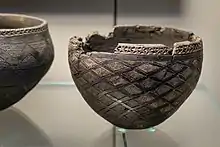C-Group culture
The C-Group culture is an archaeological culture found in Lower Nubia, which dates from ca. 2400 BCE to ca. 1550 BCE.[1] It was named by George A. Reisner. With no central site and no written evidence about what these people called themselves, Reisner assigned the culture a letter. The C-Group arose after Reisner's A-Group and B-Group cultures, and around the time the Old Kingdom was ending in Ancient Egypt.[2]
 Bowl of the C-Group, Musée du Louvre | |
| Regions with significant populations | |
|---|---|
| Nubia | |
| Languages | |
| Afroasiatic languages | |
| Related ethnic groups | |
| A-Group, B-Group, Kerma culture |
Overview
While today many scholars see A and B as actually being a continuation of the same group, C-Group is considered as the product of Saharan pastoralist distinct.[3] The C-Group is marked by its distinctive pottery, and for its tombs.[4] Early C-Group tombs consisted of a simple "stone circle" with the body buried in a depression in the centre. The tombs later became more elaborate with the bodies being placed in a stone lined chamber, and then the addition of an extra chamber on the east: for offerings.[5]
The origins of the C-Group are still debated. Some scholars see it largely being evolved from the A/B-Group. Others think it more likely that the C-Group was brought by invaders or migrants that mingled with the local culture, with the C-Group perhaps originating in the then rapidly drying Sahara.[6]
The C-Group were farmers and semi-nomadic herders keeping large numbers of cattle in an area that is today too arid for such herding. Originally they were believed to be a peaceful people due to the lack of weapons in tombs; however, daggers, short swords and battle-axes were found in C-Group graves.[7] Their settling around the forts built by the ancient Egyptians was seen as further evidence.[8]

Most of what is known about the C-Group peoples comes from Lower Nubia and the Dongola Reach.[9] The northern border of the C-Group was around el-Kubanieh near Aswan. The southern border is still uncertain, but C-Group sites have been found as far south as Eritrea.[10]
During the Egyptian Sixth Dynasty, Lower Nubia is described of consisting of a number of small states, three of which are named: Setju, Wawat, and Irjet.[11] At this same time in Upper Nubia the Kingdom of Kerma was emerging. The exact relation between the C-Group and Kerma are uncertain, but early Kerma shows definite similarities to the C-Group culture and the Pan-Grave culture.[12]
Under the Middle Kingdom much of the C-Group lands in Lower Nubia were conquered by Egypt; after the Egyptians left, Kerma expanded north controlling the region.[13] Starting with the conquest of Nubia by Egypt under Tuthmosis I in the late 16th century BCE, the C-Group merged with the Egyptians.[14]
Language
According to Peter Behrens (1981) and Marianne Bechaus-Gerst (2000), linguistic evidence indicates that the C-Group peoples spoke Afro-Asiatic languages of the Berber branch.[15][16] This thesis rests on somewhat sketchy and numerically insufficient lexical evidence. Recent evidence suggests that the C-Group peoples spoke an Afro-Asiatic language of the Cushitic branch (with peoples to the south in Upper Nubia possibly speaking Nilo-Saharan languages),[17] and that the closest relative of the C-Group language is the Beja language spoken in the Red Sea coast. Research cannot point to Beja specifically as a descendant language, but rather it is proposed to search in Beja lexical material for the closest common ancestor and thence delineates a related Cushitic language existing in pre-Meroitic Lower Nubia. The disappearance of the C-Group language is somewhat of a mystery. It is possible that with successive phases of Egyptian, Kushite, and Meroitic suzerainty in Lower Nubia that this language became demographically and politically marginalized well before the arrival of Nile Nubian speakers.[18]
Notes
- "Ancient Nubia: C-Group–Pan Grave–Kerma 2400–1550 BC". The Oriental Institute. Retrieved 1 July 2016.
- Bianchi, Robert Steven (2004). Daily Life of the Nubians. Greenwood Publishing Group. p. 33. ISBN 9780313325014.
- Shinnie (2013-10-28). Ancient Nubia. Routledge. p. 55. ISBN 9781136164651.
- Jr, Richard A. Lobban (2003-12-09). Historical Dictionary of Ancient and Medieval Nubia. Scarecrow Press. p. 100. ISBN 9780810865785.
- Wharton, William M. (1960). The Sudan in pre-history and history: a handbook for students. St. Joseph's Press. p. 24.
- Bard, Kathryn A. (2005-11-03). Encyclopedia of the Archaeology of Ancient Egypt. Routledge. p. 185. ISBN 9781134665259.
- Africa, Unesco International Scientific Committee for the Drafting of a General History of (1981). Ancient Civilizations of Africa. University of California Press. p. 253. ISBN 9780435948054.
- Török, László (2009). Between Two Worlds: The Frontier Region Between Ancient Nubia and Egypt, 3700 BC-AD 500. BRILL. p. 95. ISBN 978-9004171978.
- Edwards, David N. (2004-07-29). The Nubian Past: An Archaeology of the Sudan. Routledge. p. 77. ISBN 9781134200870.
- Shinnie (2013-10-28). Ancient Nubia. Routledge. p. 77. ISBN 9781136164736.
- Wilkinson, Toby; Wilkinson, Professor of Egyptology and Deputy Vice Chancellor Toby (2013-05-13). The Egyptian World. Routledge. p. 405. ISBN 978-1136753770.
- Bard, Kathryn A. (2005-11-03). Encyclopedia of the Archaeology of Ancient Egypt. Routledge. p. 405. ISBN 9781134665259.
- Ben-Tor, Daphna (2007). Scarabs, Chronology, and Interconnections: Egypt and Palestine in the Second Intermediate Period. Saint-Paul. p. 53. ISBN 9783727815935.
- McInerney, Jeremy (2014-06-13). A Companion to Ethnicity in the Ancient Mediterranean. John Wiley & Sons. p. 380. ISBN 9781118834381.
- Marianne Bechaus-Gerst, Roger Blench, Kevin MacDonald (ed.) (2014). The Origins and Development of African Livestock: Archaeology, Genetics, Linguistics and Ethnography - "Linguistic evidence for the prehistory of livestock in Sudan" (2000). Routledge. p. 453. ISBN 978-1135434168. Retrieved 15 September 2014.CS1 maint: extra text: authors list (link)
- Behrens, Peter (1986). Libya Antiqua: Report and Papers of the Symposium Organized by Unesco in Paris, 16 to 18 January 1984 - "Language and migrations of the early Saharan cattle herders: the formation of the Berber branch". Unesco. p. 30. ISBN 9231023764. Retrieved 14 September 2014.
- Cooper J (2017). "Toponymic Strata in Ancient Nubian placenames in the Third and Second Millenium BCE: a view from Egyptian Records". Dotawo: A Journal of Nubian Studies. 4: 201–202, 204.
- Cooper, Julien (2017) "Toponymic Strata in Ancient Nubia Until the Common Era," Dotawo: A Journal of Nubian Studies: Vol. 4 , Article 3. Available at: http://digitalcommons.fairfield.edu/djns/vol4/iss1/3
References
- Oliver, Roland (1978). The Cambridge history of Africa. Vol. 2, From c. 500 BC to AD 1050. Cambridge: Cambridge University Press. pp. 858 Pages. ISBN 0-521-21592-7.
